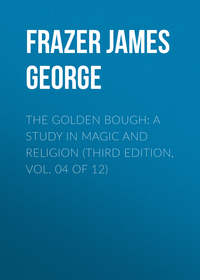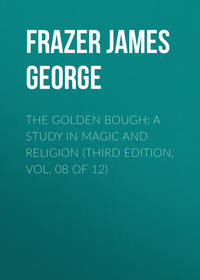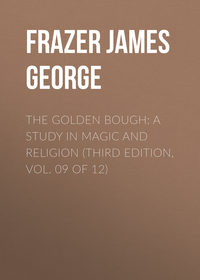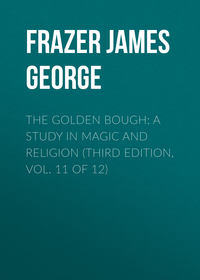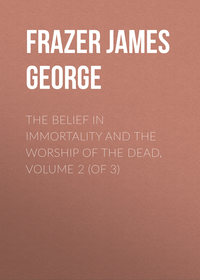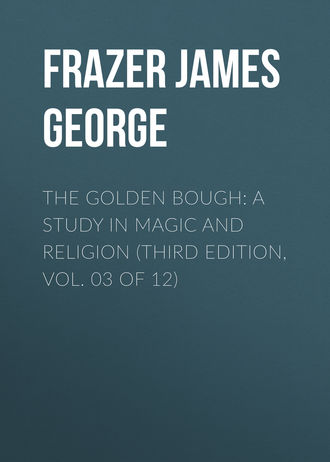 полная версия
полная версияThe Golden Bough: A Study in Magic and Religion (Third Edition, Vol. 03 of 12)
1319
On this latter motive see especially the remarks of A. W. Howitt, in Kamilaroi and Kurnai, p. 249. Compare also C. W. Schurmann, in Native Tribes of South Australia, p. 247; F. Bonney, in Journal of the Anthropological Institute, xiii. (1884) p. 127.
1320
A. Oldfield, “The Aborigines of Australia,” Transactions of the Ethnological Society of London, N.S., iii. (1865) p. 238.
1321
A. Oldfield, op. cit. p. 240.
1322
W. Stanbridge, “On the Aborigines of Victoria,” Transactions of the Ethnological Society of London, N.S., i. (1861) p. 299.
1323
A. W. Howitt, “On some Australian Beliefs,” Journal of the Anthropological Institute, xiii. (1884) p. 191; id., Native Tribes of South-East Australia, p. 440.
1324
Id., Native Tribes of South-East Australia, p. 469.
1325
G. F. Angas, Savage Life and Scenes in Australia and New Zealand (London, 1847), i. 94.
1326
Spencer and Gillen, Native Tribes of Central Australia, p. 498.
1327
Spencer and Gillen, Northern Tribes of Central Australia, p. 526.
1328
E. Clement, “Ethnographical Notes on the Western Australian Aborigines,” Internationales Archiv für Ethnographie, xvi. (1904) p. 9.
1329
L. H. Morgan, League of the Iroquois (Rochester, U.S., 1851), p. 175.
1330
A. S. Gatschett, The Klamath Indians of South-Western Oregon (Washington, 1890) (Contributions to North American Ethnology, vol. ii. pt. 1), p. xli; Chase, quoted by H. H. Bancroft, Native Races of the Pacific States, i. 357, note 76.
1331
S. Powers, Tribes of California, p. 33; compare p. 68.
1332
S. Powers, op. cit. p. 240.
1333
F. A. Simons, “An Exploration of the Goajira Peninsula, U.S. of Colombia,” Proceedings of the Royal Geographical Society, vii. (1885) p. 791.
1334
M. Dobrizhoffer, Historia de Abiponibus, ii. 301, 498. For more evidence of the observance of this taboo among the American Indians see A. Woldt, Captain Jacobsen's Reise an der Nordwestküste Americas (Leipsic, 1884), p. 57 (as to the Indians of the north-west coast); W. Colquhoun Grant, “Description of Vancouver's Island,” Journal of the Royal Geographical Society, xxvii. (1857) p. 303 (as to Vancouver Island); Capt. Wilson, “Report on the Indian Tribes,” Transactions of the Ethnological Society of London, N.S., iv. (1866) p. 286 (as to Vancouver Island and neighbourhood); C. Hill Tout, in Journal of the Anthropological Institute, xxxv. (1905) p. 138; id., The Far West, the Land of the Salish and Déné, p. 201; A. Ross, Adventures on the Oregon or Columbia River, p. 322; H. R. Schoolcraft, Indian Tribes, iv. 226 (as to the Bonaks of California); Ch. N. Bell, “The Mosquito Territory,” Journal of the Royal Geographical Society, xxxii. (1862) p. 255; A. Pinart, “Les Indiens de l'Etat de Panama,” Revue d'Ethnographie, vi. (1887) p. 56; G. C. Musters, in Journal of the Royal Geographical Society, xli. (1871) p. 68 (as to Patagonia). More evidence is adduced below.
1335
See P. S. Pallas, Reise durch verschiedene Provinzen des russischen Reichs, iii. 76 (Samoyeds); J. W. Breeks, Account of the Primitive Tribes and Monuments of the Nīlagiris (London, 1873), p. 19; W. E. Marshall, Travels amongst the Todas, p. 177; W. H. R. Rivers, The Todas, pp. 462, 496, 626; Plan de Carpin (de Plano Carpini), Relation des Mongols ou Tartares, ed. D'Avezac, cap. iii. § iii.; H. Duveyrier, Exploration du Sahara, les Touareg du nord (Paris, 1864), p. 415; Lieut. S. C. Holland, “The Ainos,” Journal of the Anthropological Institute, iii. (1874) p. 238; J. Batchelor, The Ainu and their Folk-lore (London, 1901), pp. 252, 564; J. M. Hildebrandt, “Ethnographische Notizen über Wakamba und ihre Nachbarn,” Zeitschrift für Ethnologie, x. (1878) p. 405; A. C. Hollis, The Nandi, p. 71; F. Blumentritt, Versuch einer Ethnographie der Philippinen (Gotha, 1882), p. 38 (Petermann's Mittheilungen, Ergänzungsheft, No. 67); N. Fontana, “On the Nicobar Isles,” Asiatick Researches, iii. (London, 1799) p. 154; W. H. Furness, Folk-lore in Borneo (Wallingford, Pennsylvania, 1899), p. 26; A. van Gennep, Tabou et totémisme à Madagascar, pp. 70 sq.; J. E. Calder, “Native Tribes of Tasmania,” Journal of the Anthropological Institute, iii. (1874) p. 23; J. Bonwick, Daily Life of the Tasmanians, pp. 97, 145, 183.
1336
H. Duveyrier, Exploration du Sahara, les Touareg du nord, p. 431.
1337
J. Dawson, Australian Aborigines, p. 42.
1338
K. Vetter, Komm herüber und hilf uns! iii. (Barmen, 1898) p. 24; id., in Nachrichten über Kaiser Wilhelms-Land und den Bismarck-Archipel, 1897, p. 92.
1339
Dr. L. Loria, “Notes on the ancient War Customs of the Natives of Logea,” British New Guinea, Annual Report for 1894-95, pp. 45, 46 sq. Compare M. Krieger, Neu-Guinea, p. 322.
1340
Myron Eels, “The Twana, Chemakum, and Klallam Indians of Washington Territory,” Annual Report of the Smithsonian Institute for 1887, part i. p. 656.
1341
Baron C. C. von der Decken, Reisen in Ost-Afrika (Leipsic, 1869-1871), ii. 25; R. Andree, Ethnographische Parallelen und Vergleiche, pp. 182 sq.
1342
S. L. Hinde and H. Hinde, The last of the Masai (London, 1901), p. 50; Sir H. Johnston, The Uganda Protectorate, ii. 826.
1343
W. Wyatt, in Native Tribes of South Australia, p. 165.
1344
D. Collins, Account of the English Colony in New South Wales (London, 1804), p. 392.
1345
P. Beveridge, “Notes on the Dialects, Habits, and Mythology of the Lower Murray Aborigines,” Transactions of the Royal Society of Victoria, vi. 20 sq.
1346
“Description of the Natives of King George's Sound (Swan River) and adjoining Country,” Journal of the R. Geographical Society, i. (1832) pp. 46 sq.
1347
W. E. Roth, North Queensland Ethnography, Bulletin No. 5 (Brisbane, 1903), § 72, p. 20.
1348
G. F. Angas, Savage Life and Scenes in Australia and New Zealand (London, 1847), ii. 228.
1349
J. F. Lafitau, Mœurs des sauvages ameriquains, ii. 434; R. Southey, History of Brazil, iii. 894 (referring to Roger Williams).
1350
Charlevoix, Histoire de la Nouvelle France, vi. 109.
1351
S. Powers, Tribes of California, p. 349; Myron Eels, “The Twana, Chemakum, and Klallam Indians of Washington Territory,” Annual Report of the Smithsonian Institute for 1887, p. 656.
1352
S. L. Hinde and H. Hinde, The Last of the Masai, p. 50.
1353
J. Dawson, Australian Aborigines, p. 42.
1354
H. H. Bancroft, Native Races of the Pacific States, i. 248. Compare K. F. v. Baer und Gr. v. Helmersen, Beiträge zur Kenntniss des russischen Reiches und der angränzenden Länder Asiens, i. (St. Petersburg, 1839), p. 108 (as to the Kenayens of Cook's Inlet and the neighbourhood).
1355
J. Mooney, “Calendar History of the Kiowa Indians,” Seventeenth Annual Report of the Bureau of American Ethnology, part i. (Washington, 1898) p. 231.
1356
F. de Azara, Voyages dans l'Amérique Méridionale (Paris, 1808), ii. 153 sq.
1357
P. Lozano, Descripcion chorographica, etc., del Gran Chaco (Cordova, 1733), p. 70.
1358
E. H. Man, “Notes on the Nicobarese,” Indian Antiquary, xxviii. (1899) p. 261. Elsewhere I have suggested that mourning costume in general may have been adopted with this intention. See Journal of the Anthropological Institute, xv. (1886) pp. 73, 98 sqq.
1359
J. Enderli, “Zwei Jahre bei den Tchuktschen und Korjaken,” Petermanns Mitteilungen, xlix. (1903) p. 257.
1360
R. Brough Smyth, Aborigines of Victoria, ii. 266.
1361
E. J. Eyre, Journals of Expeditions of Discovery, ii. 354 sq.
1362
J. Macgillivray, Narrative of the Voyage of H.M.S. Rattlesnake (London, 1852), ii. 10 sq.
1363
J. Bulmer, in Brough Smyth's Aborigines of Victoria, ii. 94.
1364
H. E. A. Meyer, in Native Tribes of South Australia, p. 199, compare p. xxix.
1365
J. Dawson, Australian Aborigines, p. 43. Mr. Howitt mentions the case of a native who arbitrarily substituted the name nobler (“spirituous liquor”) for yan (“water”) because Yan was the name of a man who had recently died (Kamilaroi and Kurnai, p. 249).
1366
M. Dobrizhoffer, Historia de Abiponibus (Vienna, 1784), ii. 199, 301.
1367
H. Ten Kate, “Notes ethnographiques sur les Comanches,” Revue d'Ethnographie, iv. (1885) p. 131.
1368
J. Mooney, “Calendar History of the Kiowa Indians,” Seventeenth Annual Report of the Bureau of American Ethnology, part i. (Washington, 1898) p. 231.
1369
Rev. J. Roscoe in a letter to me dated Mengo, Uganda, 17th February 1904.
1370
A. C. Hollis, The Masai (Oxford, 1905), pp. 304 sq. As to the Masai customs in this respect see also above, pp. 354 sq., 356.
1371
J. H. W. van der Miesen, “Een en ander over Boeroe,” Mededeelingen van wege het Nederlandsche Zendelinggenootschap, xlvi. (1902) p. 455.
1372
Sir William Macgregor, British New Guinea (London, 1897), p. 79.
1373
C. G. Seligmann, The Melanesians of British New Guinea (Cambridge, 1910), pp. 629-631.
1374
F. W. Christian, The Caroline Islands (London, 1899), p. 366.
1375
F. A. de Roepstorff, “Tiomberombi, a Nicobar Tale,” Journal of the Asiatic Society of Bengal, liii. (1884) pt. i. pp. 24 sq. In some tribes apparently the names of the dead are only tabooed in the presence of their relations. See C. Hill-Tout, in “Report of the Committee on the Ethnological Survey of Canada,” Report of the British Association for the Advancement of Science, Bradford, 1900, p. 484; G. Brown, Melanesians and Polynesians (London, 1910), p. 399. But in the great majority of the accounts which I have consulted no such limitation of the taboo is mentioned.
1376
A. S. Gatschet, The Klamath Indians of South-Western Oregon (Washington, 1890), p. xli. (Contributions to North American Ethnology, vol. ii. pt. I).
1377
P. Beveridge, “Of the Aborigines inhabiting the great Lacustrine and Riverine Depression of the Lower Murray,” etc., Journal and Proceedings of the Royal Society of New South Wales for 1883, vol. xvii. p. 65. The custom of changing common words on the death of persons who bore them as their names seems also to have been observed by the Tasmanians. See J. Bonwick, Daily Life of the Tasmanians, p. 145.
1378
G. Grey, Journals of two Expeditions of Discovery in North-West and Western Australia, ii. 231 sq.
1379
J. Dawson, Australian Aborigines, p. 42.
1380
C. W. Schürmann, in Native Tribes of South Australia, p. 247.
1381
H. H. Bancroft, Native Races of the Pacific States, iii. 156.
1382
Myron Eels, “The Twana, Chemakum, and Klallam Indians of Washington Territory,” Annual Report of the Smithsonian Institution for 1887, p. 656.
1383
S. R. M'Caw, “Mortuary Customs of the Puyallups,” The American Antiquarian and Oriental Journal, viii. (1886) p. 235.
1384
J. F. Lafitau, Mœurs des sauvages ameriquains (Paris, 1724), ii. 434. Charlevoix merely says that the taboo on the names of the dead lasted “a certain time” (Histoire de la Nouvelle France, vi. 109). “A good long while” is the phrase used by Captain J. G. Bourke in speaking of the same custom among the Apaches (On the Border with Crook, p. 132).
1385
Gabriel Sagard, Le Grand Voyage du pays des Hurons, Nouvelle Édition (Paris, 1865), p. 202. The original edition of Sagard's book was published at Paris in 1632.
1386
Relations des Jésuites, 1636, p. 131; id., 1642, pp. 53, 85; id., 1644, pp. 66 sq. (Canadian reprint, Quebec, 1858).
1387
Daniel W. Harmon, quoted by Rev. Jedidiah Morse, Report to the Secretary of War of the United States on Indian Affairs (New-Haven, 1822), Appendix, p. 345. The custom seems now to be extinct. It is not mentioned by Father A. G. Morice in his accounts of the tribe (in Proceedings of the Canadian Institute, Third Series, vol. vii. 1888-89; Transactions of the Canadian Institute, vol. iv. 1892-93; Annual Archaeological Report, Toronto, 1905).
1388
Ch. Wilkes, Narrative of the United States Exploring Expedition (New York, 1851), iv. 453.
1389
E. J. Jessen, De Finnorum Lapponumque Norwegicorum religione pagana, pp. 33 sq. (bound up with C. Leemius, De Lapponibus Finmarchiae eorumque lingua, vita, et religione pristina commentatio, Copenhagen, 1767).
1390
Major S. C. Macpherson, Memorials of Service in India (London, 1865), pp. 72 sq.
1391
C. Spiess, “Einiges über die Bedeutung der Personennamen der Evheer in Togo-Gebiete,” Mittheilungen des Seminars für orientalische Sprachen zu Berlin, vi. (1903) Dritte Abtheilung, pp. 56 sq.
1392
A. B. Ellis, The Yoruba-speaking Peoples of the Slave Coast, p. 152; id., The Ewe-speaking Peoples of the Slave Coast, pp. 153 sq. In the former passage the writer says nothing about the child's name. In the latter he merely says that an ancestor is supposed to have sent the child, who accordingly commonly takes the name of that ancestor. But the analogy of other peoples makes it highly probable that, as Col. Ellis himself states in his later work (The Yoruba-speaking Peoples), the ancestor is believed to be incarnate in the child. That the Yoruba child takes the name of the ancestor who has come to life again in him is definitely stated by A. Dieterich in Archiv für Religionswissenschaft, viii. (1904) p. 20, referring to Zeitschrift für Missionskunde und Religionswissenschaft, xv. (1900) p. 17, a work to which I have not access. Dieterich's account of the subject of rebirth (op. cit. pp. 18-21) deserves to be consulted.
1393
J. Roscoe, “Further Notes on the Manners and Customs of the Baganda,” Journal of the Anthropological Institute, xxxii. (1902) p. 32.
1394
C. Mauch, Reisen im Inneren von Süd-Afrika (Gotha, 1874), p. 43 (Petermann's Mittheilungen, Ergänsungsheft, No. 37).
1395
Sir R. C. Temple, in Census of India, 1901, vol. iii. 207, 212.
1396
Plan de Carpin (de Plano Carpini), Relation des Mongols ou Tartares, ed. D'Avezac, cap. iii. § iii. The writer's statement (“nec nomen proprium ejus usque ad tertiam generationem audet aliquis nominare”) is not very clear.
1397
P. Labbé, Un Bagne russe, l'île de Sakhaline (Paris, 1903), p. 166.
1398
E. W. Nelson, “The Eskimo about Bering Strait,” Eighteenth Annual Report of the Bureau of American Ethnology, part i. (Washington, 1899), pp. 363 sq., 365, 368, 371, 377, 379, 424 sq.
1399
On the doctrine of the reincarnation of ancestors in their descendants see E. B. Tylor, Primitive Culture,2 ii. 3-5, who observes with great probability that “among the lower races generally the renewal of old family names by giving them to new-born children may always be suspected of involving some such thought.” See further Totemism and Exogamy, iii. 297-299.
1400
H. H. Bancroft, Native Races of the Pacific States, i. 248.
1401
G. Taplin, in Native Tribes of South Australia, p. 19.
1402
H. E. A. Meyer, in Native Tribes of South Australia, p. 199.
1403
Some of the Indians of Guiana bring food and drink to their dead so long as the flesh remains on the bones; when it has mouldered away, they conclude that the man himself has departed. See A. Biet, Voyage de la France équinoxiale en l'Isle de Cayenne (Paris, 1664), p. 392. The Alfoors or Toradjas of central Celebes believe that the souls of the dead cannot enter the spirit-land until all the flesh has been removed from their bones; till that has been done, the gods (lamoa) in the other world could not bear the stench of the corpse. Accordingly at a great festival the bodies of all who have died within a certain time are dug up and the decaying flesh scraped from the bones. See A. C. Kruijt, “Een en ander aangaande het geestelijk en maatschappelijk leven van den Poso-Alfoer,” Mededeelingen van wege het Nederlandsche Zendelinggenootschap, xxxix. (1895) pp. 26, 32 sqq.; id., “Het wezen van het Heidendom te Posso,” ibid. xlvii. (1903) p. 32. The Matacos Indians of the Gran Chaco believe that the soul of a dead man does not pass down into the nether world until his body is decomposed or burnt. See J. Pelleschi, Los Indios Matacos (Buenos Ayres, 1897), p. 102. These ideas perhaps explain the widespread custom of disinterring the dead after a certain time and disposing of their bones otherwise.
1404
Spencer and Gillen, Native Tribes of Central Australia, pp. 498-508.
1405
A. B. Ellis, The Ewe-speaking Peoples of the Slave Coast, pp. 98 sq.
1406
A. Cecchi, Da Zeila alle frontiere del Caffa, ii. (Rome, 1885) p. 551.
1407
Rev. J. Roscoe, “The Bahima,” Journal of the Royal Anthropological Institute, xxxvii. (1907) p. 96.
1408
J. F. Cunningham, Uganda and its Peoples (London, 1905), pp. 14, 16.
1409
De la Loubere, Du royaume de Siam (Amsterdam, 1691), i. 306; Pallegoix, Royaume Thai ou Siam, i. 260.
1410
J. S. Polack, Manners and Customs of the New Zealanders (London, 1840), ii. 127, note 43.
1411
A. Fytche, Burma Past and Present (London, 1878), i. 238.
1412
J. Edkins, Religion in China2 (London, 1878), p. 35.
1413
Ch. Dallet, Histoire de l'Église de Corée, i. p. xxiv.; Mrs. Bishop, Korea and her Neighbours (London, 1898), i. 48. The custom is now obsolete (G. N. Curzon, Problems of the Far East, Westminster, 1896, p. 155 note).
1414
E. Aymonier, Notice sur le Cambodge (Paris, 1875), p. 22; id., Le Cambodge, i. (Paris, 1900) p. 58.
1415
K. F. Holle, “Snippers van den Regent van Galoeh,” Tijdschrift voor Indische Taal- Land- en Volkenkunde, xxvii. (1882) p. 101.
1416
N. P. Wilken en J. A. Schwarz, “Allerlei over het land en volk van Bolaang Mongondou,” Mededeelingen van wege het Nederlandsche Zendelinggenootschap, xi. (1867) p. 356.
1417
S. Roos, “Bijdrage tot de Kennis van Taal, Land, en Volk op het eiland Soemba,” p. 70, Verhandelingen van het Bataviaasch Genootschap van Kunsten en Wetenschappen, xxxvi. Compare J. H. F. Kohlbrugge, “Naamgeving in Insulinde,” Bijdragen tot de Taal- Land- en Volkenkunde van Nederlandsche-Indië, ii. (1900) p. 173.
1418
Above, pp. 335 sq.
1419
J. Shooter, The Kafirs of Natal and the Zulu Country, pp. 221 sq.; David Leslie, Among the Zulus and Amatongas2 (Edinburgh, 1875), pp. 172-179; J. Macdonald, “Manners, Customs, Superstitions, and Religions of South African Tribes,” Journal of the Anthropological Institute, xx. (1891) p. 131. The account in the text is based mainly on Leslie's description, which is by far the fullest.
1420
D. Tyerman and G. Bennet, Journal of Voyages and Travels (London, 1831), ii. 525 sq.; J. Sibree, The Great African Island (London, 1880), pp. 150 sq.; id., “Curiosities of Words connected with Royalty and Chieftainship,” Antananarivo Annual and Madagascar Magazine, No. xi. (Christmas, 1887) pp. 308 sq.; id., in Journal of the Anthropological Institute, xxi. (1887) pp. 226 sqq. On the custom of tabooing royal or chiefly names in Madagascar, see A. van Gennep, Tabou et totémisme à Madagascar (Paris, 1904), pp. 104 sqq.
1421
V. Noel, “Île de Madagascar, recherches sur les Sakkalava,” Bulletin de la Société de Géographie (Paris), IIme Série, xx. (1843) pp. 303-306. Compare A. Grandidier, “Les Rites funéraires chez les Malgaches,” Revue d'Ethnographie, v. (1886) p. 224; A. Walen, “The Sakalava,” Antananarivo Annual and Madagascar Magazine, vol. ii., Reprint of the Second Four Numbers (Antananarivo, 1896), p. 242; A. van Gennep, Tabou et totémisme à Madagascar, pp. 110 sq. Amongst the Sakalavas it is forbidden to mention the name of any dead person. See A. Voeltzkow, “Vom Morondava zum Mangoky, Reiseskizzen aus West-Madagascar,” Zeitschrift der Gesellschaft für Erdkunde zu Berlin, xxxi. (1896) p. 118.


